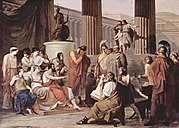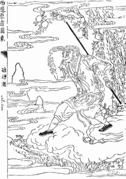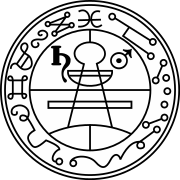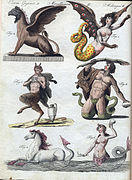
Myth is a genre of folklore consisting primarily of narratives that play a fundamental role in a society. For scholars, this is very different from the vernacular usage of the term "myth" that refers to a belief that is not true. Instead, the veracity of a myth is not a defining criterion.
Myths are often endorsed by secular and religious authorities and are closely linked to religion or spirituality. Many societies group their myths, legends, and history together, considering myths and legends to be factual accounts of their remote past. In particular, creation myths take place in a primordial age when the world had not achieved its later form. Origin myths explain how a society's customs, institutions, and taboos were established and sanctified. National myths are narratives about a nation's past that symbolize the nation's values. There is a complex relationship between recital of myths and the enactment of rituals. (Full article...)
Inanna is the ancient Mesopotamian goddess of love, war, and fertility. She is also associated with sensuality, procreation, divine law, and political power. Originally worshipped in Sumer, she was known by the Akkadian Empire, Babylonians, and Assyrians as Ishtar (and occasionally the logogram 𒌋𒁯). Her primary title is "the Queen of Heaven".
She was the patron goddess of the Eanna temple at the city of Uruk, her early main cult center. In archaic Uruk she was worshipped in three forms: morning Inanna (Inana-UD/hud), evening Inanna (Inanna sig) and princely Inanna (Inanna NUN), the former two reflecting the phases of her associated planet Venus. Her most prominent symbols include the lion and the eight-pointed star. Her husband is the god Dumuzid (later known as Tammuz), and her sukkal (attendant) is the goddess Ninshubur, later conflated with the male deities Ilabrat and Papsukkal. (Full article...)
- ... that the Engkanto, a Philippine mythical creature, might be based on early encounters with European friars?
- ...that the most popular deity worshipped by the Duala peoples of Cameroon is a mermaid called a jengu?
- ...that Tlahuizcalpantecuhtli (pictured) was the god of the planet Venus in Aztec belief?
- ...that in Greek mythology, Antiope was the only Amazon known to have married?
Featured Articles:
Ahalya,
Ancient Egyptian literature,
King Arthur,
Ganesha,
Iravan,
Orion (mythology),
Vampire,
Vithoba
Featured Lists:
List of valkyrie names in Norse mythology
Good Articles:
2012 phenomenon,
Æsir–Vanir War,
Ala (demon),
Anu,
Aphrodite,
Athena,
Ardhanarishvara,
Battle of Barry,
Bhikshatana,
Catalogue of Women,
Chamunda,
Chhinnamasta,
Consorts of Ganesha,
Cú Chulainn,
Dhumavati,
Dumuzid,
Einherjar,
Eir,
Enlil,
Fairy Flag,
Fenrir,
Gerðr,
Hel (being),
Huginn and Muninn,
Iðunn,
Ila (Hinduism),
Inanna,
Kabandha,
Kali,
Kamadhenu,
Kangiten,
Keshi (demon),
Khandoba,
Kratos (mythology)
Krishna,
Kubera,
LGBT themes in Hindu mythology,
Manasa,
Mandodari,
Matangi,
Matrikas,
Maya Sita,
Mohini,
Myrrha,
Mythology of Carnivàle,
Naraka (Hinduism),
Ninurta,
Prester John,
Prithu,
Putana,
Rati,
Ratatoskr,
Revanta,
Satyavati,
Satyr,
Sharabha,
Shashthi,
Shiva,
Sif,
Tara (Ramayana),
Troilus,
Tuisto,
Valhalla,
Valkyrie,
Vampire folklore by region,
Varaha,
Varahi,
Veðrfölnir and eagle
Zduhać

Fenrir (Old Norse 'fen-dweller') or Fenrisúlfr (Old Norse "Fenrir's wolf", often translated "Fenris-wolf"), also referred to as Hróðvitnir (Old Norse "fame-wolf") and Vánagandr (Old Norse 'monster of the [River] Ván'), is a monstrous wolf in Norse mythology. In Old Norse texts, Fenrir plays a key role during the events of Ragnarök, where he is foretold to assist in setting the world aflame, resulting in the collapse of humanity and society, and kill the god Odin.
Fenrir, along with Hel and Jörmungandr, is a child of Loki and female jötunn Angrboða. He is attested in the Poetic Edda, compiled in the 13th century from earlier traditional sources, and the Prose Edda and Heimskringla, composed in the 13th century. In both the Poetic Edda and Prose Edda, Fenrir is the father of the wolves Sköll and Hati Hróðvitnisson, is a son of Loki and is foretold to kill the god Odin during the events of Ragnarök, but will in turn be killed by Odin's son Víðarr. (Full article...)
- Help with the myth and folklore missing articles project.
- Help create requested articles.
- Help assessment at Wikipedia:WikiProject Mythology/Assessment.
- Place the project banner {{WikiProject Mythology}} on the talk pages of all relevant articles.
- Check the recent changes for recent improvements, vandalism, and other changes.
- Answer requests for mythology articles needing attention: Category:Mythology articles needing attention
- Answer requests for mythology articles needing expert attention: Category:Mythology articles needing expert attention
- Expand articles tagged as mythology stubs: Category:Mythology stubs
- Assist mythology subprojects.
- Add requested photographs of mythology subjects: Category:Wikipedia requested photographs of mythology subjects
The following Wikimedia Foundation sister projects provide more on this subject:
-
Commons
Free media repository -
Wikibooks
Free textbooks and manuals -
Wikidata
Free knowledge base -
Wikinews
Free-content news -
Wikiquote
Collection of quotations -
Wikisource
Free-content library -
Wikiversity
Free learning tools -
Wiktionary
Dictionary and thesaurus













































































































